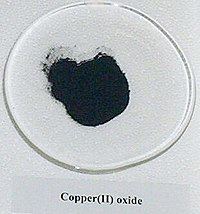Appearance black to brown powder Formula CuO Molar mass 79.545 g/mol Density 6.31 g/cm³ | Related compounds IUPAC ID Copper(II) oxide Melting point 1,326 °C Boiling point 2,000 °C | |
 | ||
Copper(II) oxide or cupric oxide is the inorganic compound with the formula CuO. A black solid, it is one of the two stable oxides of copper, the other being Cu2O or cuprous oxide. As a mineral, it is known as tenorite and paramelaconite. It is a product of copper mining and the precursor to many other copper-containing products and chemical compounds.
Contents
Production
It is produced on a large scale by pyrometallurgy used to extract copper from ores. The ores are treated with an aqueous mixture of ammonium carbonate, ammonia, and oxygen to give copper(I) and copper(II) ammine complexes, which are extracted from the solids. These complexes are decomposed with steam to give CuO.
It can be formed by heating copper in air at around 300 - 800°C:
2 Cu + O2 → 2 CuOFor laboratory uses, pure copper(II) oxide is better prepared by heating copper(II) nitrate, copper(II) hydroxide or copper(II) carbonate:
2 Cu(NO3)2 → 2 CuO + 4 NO2 + O2Cu(OH)2 (s) → CuO (s) + H2O (l)CuCO3 → CuO + CO2Reactions
Copper(II) oxide is an amphoteric oxide, so it dissolves in mineral acids such as hydrochloric acid, sulfuric acid or nitric acid to give the corresponding copper(II) salts:
CuO + 2 HNO3 → Cu(NO3)2 + H2OCuO + 2 HCl → CuCl2 + H2OCuO + H2SO4 → CuSO4 + H2OIt reacts with concentrated alkali to form the corresponding cuprate salts:
2 MOH + CuO + H2O → M2[Cu(OH)4]It can also be reduced to copper metal using hydrogen, carbon monoxide, or carbon:
CuO + H2 → Cu + H2OCuO + CO → Cu + CO22CuO + C → 2Cu + CO2When cupric oxide is substituted for iron oxide in thermite the resulting mixture is a low explosive, not an incendiary.
Structure and physical properties
Copper(II) oxide belongs to the monoclinic crystal system. The copper atom is coordinated by 4 oxygen atoms in an approximately square planar configuration.
The work function of bulk CuO is 5.3eV
Copper(II) oxide is a p-type semiconductor, with a narrow band gap of 1.2 eV. Cupric oxide can be used to produce dry cell batteries.
Uses
As a significant product of copper mining, copper(II) oxide is the starting point for the production of other copper salts. For example, many wood preservatives are produced from copper oxide.
Cupric oxide is used as a pigment in ceramics to produce blue, red, and green, and sometimes gray, pink, or black glazes.
It is also incorrectly used as a dietary supplement in animal feed. Due to low bioactivity, negligible copper is absorbed.
It is also used when welding with copper alloys.
Use in disposal
Cupric oxide can be used to safely dispose of hazardous materials such as cyanide, hydrocarbons, halogenated hydrocarbons and dioxins, through oxidation.
The decomposition reactions of phenol and pentachlorophenol follow these pathways:
C6H5OH + 14CuO → 6CO2 + 3H2O + 14CuC6Cl5OH + 2H2O + 9CuO → 6CO2 + 5HCl + 9Cu